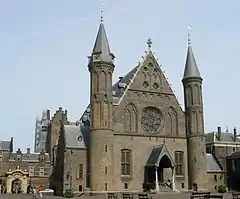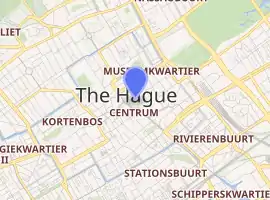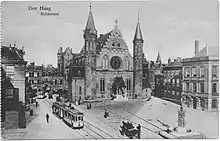Ridderzaal
The Ridderzaal (Dutch pronunciation: [ˈrɪdərzaːl]; English: Hall of Knights)[1] is the main building of the 13th-century inner square of the former castle of the counts of Holland called Binnenhof at the address Binnenhof 11 in The Hague, Netherlands. It is used for the state opening of Parliament on Prinsjesdag, when the Dutch monarch drives to Parliament in the Golden Coach and delivers the speech from the throne. It is also used for official royal receptions, and interparliamentary conferences.
| Ridderzaal | |
|---|---|
 The entrance of the Ridderzaal in 2003 | |

| |
| General information | |
| Architectural style | Gothic architecture |
| Location | Binnenhof |
| Town or city | The Hague |
| Country | Netherlands |
| Coordinates | 52.079444°N 4.312778°E |
| Completed | 13th century |
| Client | Floris V, Count of Holland |
History

In the 13th century Floris IV, Count of Holland bought a piece of land next to a small lake to build a house on. The Ridderzaal, the manorial hall of Floris V, grandson of Floris IV, was built on this estate in the 13th century. Over the centuries, the government buildings developed around this lake and incorporated the Ridderzaal. From the early 17th century, the Ridderzaal became an important trading place for booksellers, as Westminster Hall was in London. In later centuries it served a variety of purposes - as a market hall, a promenade, a drill hall, a public record office, a hospital ward, even the offices of the state lottery. It was restored between 1898 and 1904 to serve its present purposes.
The Ridderzaal was also the venue for the Dutch–Indonesian Round Table Conference in 1949.
Building
.jpg.webp)
This 40 by 20 metres (131 ft × 66 ft) large Gothic hall has magnificent stained glass windows depicting the coats of arms of Dutch towns; particularly fine is the rose window with the arms of the principal noble families of the Netherlands. The heavy timber roof structure with its 18-metre-long beams (59 ft) has the appearance of an upturned ship. Wooden heads symbolizing eavesdroppers from the higher powers are supposed to deter members of the assembly from lying.
The throne in the Ridderzaal was designed by Pierre Cuypers.[2]
References
- "The Binnenhof". Denhaag.nl. 10 April 2013. Retrieved 12 October 2013.
- Rijksgebouwendienst (September 2006). "Ridderzaal in ere hersteld" (in Dutch). Ministry of Housing, Spatial Planning and the Environment. Retrieved 2013-10-12.
External links
 Media related to Ridderzaal at Wikimedia Commons
Media related to Ridderzaal at Wikimedia Commons